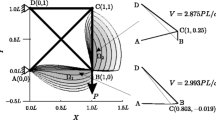Abstract
The present work discusses the optimal placement of sensors in truss structures in order to obtain best possible information regarding the distortions of the structure. The estimation goal is to reconstruct the deformed shape of the structure, at the controlled degrees of freedom, from the sensor readings. A basic assumption is that the structure is subjected to a parametric disturbance field. We distinguish between disturbances which cause uniform or arbitrary distortions of the structure, and disturbances which cause structured distortions. Uniform distortions can be construed as white noise, that is, distortions which have no characteristics. Structured distortions are chromatic, they have some characteristics which can be helpful in estimating the shape. Although the disturbance in either case is random it is assumed that its magnitude is confined to a hyper sphere. The estimator is based on the least squares method, hence the estimated shape is the one with least RMS displacement for the given sensor readings. To evaluate the performance of each set of sensors a measure is derived based on the concept of the worst case distortion. The measure is the largest possible error between the estimated and the actual displacements, at the CDOF. For small number of sensors all possible arrangements can be generated and compared. Larger trusses with a moderate number of sensors generate prohibitively large number of possible configurations, hence heuristic search techniques are employed. The theory has been applied to 2D and 3D flexible trusses. Results show that for reasonable shape estimation a relatively large number of sensors is needed. It is also shown that when using sensors which measure mainly the distortions of the controlled degrees of freedom, significant improvements in the shape estimation can be obtained.
Similar content being viewed by others
References
Das, S.K.; Utku, S.; Chen, S.K.; Wada, B.K. 1991: A mathematical basis for the design optimization of adaptive trusses in precision control.Proc. 32nd AIAA/ASME/ASCE/AHS/ASC Structures, Structural Dynamics and Materials Conf., (held in Baltimore, MD), pp. 829–839
Haftka, R.T.; Adelman, H.M. 1985: An analytical investigation of shape control of large space structures by applied temperatures.AIAA J. 23, 450–457
Hakim, S.; Fuchs, M.B. 1994: A new criterion for actuator placement in quasi static control of flexible structures under arbitrary disturbances.Proc. 45th Congress of the International Astronautical Federation. (held in Jerusalem)
Hakim, S.; Fuchs M.B. 1995: Optimal actuator placement with minimum worst case distortion criterion.Proc. 36th AIAA/ASME/ASCE/AHS/ASC Structures, Structural Dynamics and Materials Conf. (held in New-Orleans)
Hakim, S.; Fuchs M.B. 1996: Quasi-static optimal actuator placement with minimum worst case distortion criterion.AIAA J. 34, 1505–1511
Holnicki-Szulc, J.; Lopez-Almansa, F.; Rodellar J. 1993: Optimal location of actuators for active damping of vibration.AIAA J. 31, 1274–1279
Kuwao, F.; Chen, G.S.; Wada, B.K. 1991: Quasi-static shape estimation and control of adaptive truss structures.Proc. 32nd AIAA/ASME/ASCE/AHS/ASC Structures, Structural Dynamics and Materials Conf. (held in Baltimore), pp. 544–552
Moler, C.B.; Little, J.N.; Bangert, S. 1987:PC-Matlab user's guide. Sherborn: The Math Works
Strang, G. 1986:Introduction to applied mathematics. Massachusetts: Wellesley-Cambridge Press
Weeks, J.C. 1984a: Static shape determination and control for large space structures: I. The flexible beam.ASME J. of Dynamic Systems, Measurement and Control 106, 261–266
Weeks, J.C. 1984b: Static shape determination and control for large space structures: II. Large space antenna.ASME J. of Dynamic Systems, Measurement and Control 106, 267–272
Author information
Authors and Affiliations
Rights and permissions
About this article
Cite this article
Hakim, S., Fuchs, M.B. Shape estimation of distorted flexible structures. Structural Optimization 12, 237–243 (1996). https://doi.org/10.1007/BF01197363
Received:
Issue Date:
DOI: https://doi.org/10.1007/BF01197363




